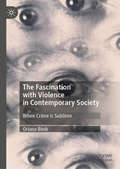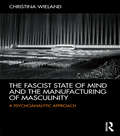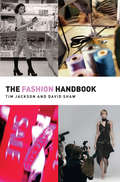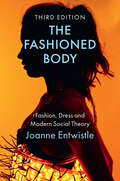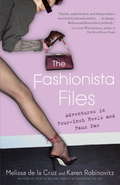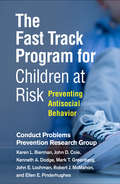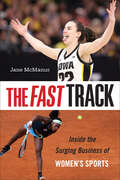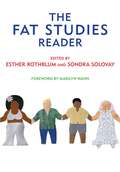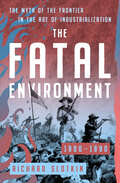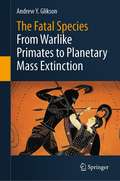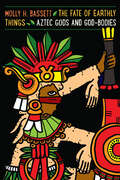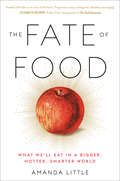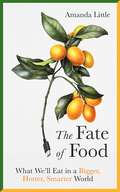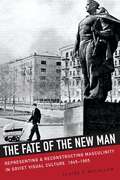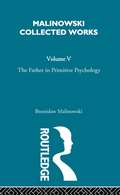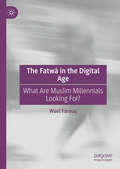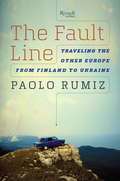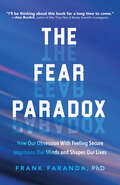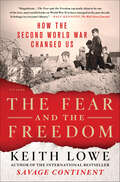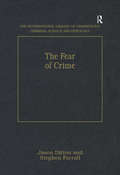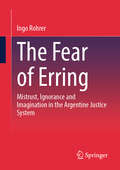- Table View
- List View
The Fascination with Violence in Contemporary Society: When Crime is Sublime (Palgrave Studies In Crime, Media And Culture Ser.)
by Oriana BinikThis book directly explores the question of why contemporary society is so fascinated with violence and crime. The Fascination with Violence in Contemporary Society posits that the phenomenon is, in part, because we have all become consumers of the sublime: an intense and strongly ambiguous emotion which is increasingly commodified. Through the experience of violence and the sense of disorientation that accompanies it, we obsessively seek out moments of intensified existence. Equally, crime continues to speak to the depths of the collective unconscious, questioning us about our transience and the model of society we wish to live in. Binik proposes that this is why the reaction to violence has become a tool with which to express and take ownership of a desire for social cohesion. This book uses interviews with viewers, dark tourists, collectors and others to further interrogate this social trend. Many of these are participants in the four key case studies explored within the study: emotional pathways while watching a true-crime TV series, the trend of dark tourism, murderabilia collecting and the fanaticism of (and for) Anders Breivik. This book seeks to answer one of the most pressing cultural trends of the modern age and fill in a gap in the criminological literature on the subject.
The Fascist State of Mind and the Manufacturing of Masculinity: A psychoanalytic approach
by Christina WielandThe Fascist State of Mind and the Manufacturing of Masculinity: A psychoanalytic approach attempts to describe in psychoanalytic terms the psychological consequences of massive social trauma and national humiliation, and the regression that takes place within the individual under these circumstances. The book is not about understanding fascism as a historical, political or sociological phenomenon, but about understanding the special relationship between masculinity and fascism and the state of mind which both shaped, and was shaped by, the historical phenomenon of fascism. Christina Wieland explores fascism as a product of certain forms of masculinity and focuses on the dynamics of masculinity as a mode of psychic functioning. She examines in detail masculine anxieties and defences and their interaction with stresses of modernity and with the social and political unrest that followed World War One. The Fascist State of Mind and the Manufacturing of Masculinity is divided into four parts: Part One – The meaning of fascism and the fascist state of mind – theories and definitions Part Two – Masculinity, its meaning and its vulnerability Part Three – Group and group theory, and the total environment Part Four – Exploring the links between masculinity, groups and fascism The Fascist State of Mind and the Manufacturing of Masculinity uses clinical material, literary texts, and extensive psychoanalytic interpretation of some passages from Mein Kampf to illustrate the interplay of the psychological processes with social and political events. This book will appeal to psychoanalysts and psychoanalytic psychotherapists, teachers and students of psychoanalysis and gender studies. It will also appeal to those interested in the application of psychoanalytic insights in the understanding of social and political phenomena.
The Fascists and the Jews of Italy
by Michael A. LivingstonFrom 1938 until 1943 - before the German occupation and accompanying Holocaust - Fascist Italy drafted and enforced a comprehensive set of anti-Semitic laws. Notwithstanding later rationalizations, the laws were enforced and administered with a high degree of severity and resulted in serious, and in some cases permanent, damage to the Italian Jewish community. Written from the perspective of an American legal scholar, this book constitutes the first truly comprehensive survey of the Race Laws in the English language. Based on an exhaustive review of Italian legal, administrative, and judicial sources, together with archives of the Italian Jewish community, Professor Michael A. Livingston demonstrates the zeal but also the occasional ambivalence and contradictions with which the Race Laws were applied and assimilated by the Italian legal order and ordinary citizens. Although frequently depressing, the history of the Race Laws also involves numerous examples of personal courage and idealism, and provides a useful and timely study of what happens when otherwise decent people are confronted with an evil and unjust legal order.
The Fashion Handbook
by Tim Jackson David ShawThe Fashion Handbook is the indispensable guide to the fashion industry. It explores the varied and diverse aspects of the business, bringing together critical concepts with practical information about the industry’s structure and core skills, as well as offering advice on real working practices and providing information about careers and training. Tracing the development of the fashion industry, this book looks at how fashion can be understood from both social and cultural perspectives. Each chapter contributes to the knowledge of a particular academic or vocational area either through building on existing research or through the dissemination of new research undertaken into specialist vocational disciplines. The Fashion Handbook uses case studies, interviews and profiles and includes chapters written by recognised academics and fashion industry experts. Specialist topics include fashion culture, luxury brands, fashion journalism, fashion buying, design and manufacturing, retailing, PR and styling. The Fashion Handbook includes: a unique and wide overview of the fashion industry chapters on specialist topics contributions from recognised experts in both academia and the fashion industry expert advice on careers in fashion retailing. A must for all students of the fashion world.
The Fashioned Body: Fashion, Dress and Modern Social Theory (Dress, Body, Culture Ser.)
by Joanne EntwistleThe Fashioned Body provides a wide-ranging and original overview of fashion and dress from an historical and sociological perspective. Where once fashion was seen as marginal, it has now entered into core economic discourse focused around ideas about 'cultural' and 'creative' work as a major driver of developed economies. This third edition of The Fashioned Body, the most comprehensive revision to date, revisits the classic works on fashion, dress and the body, and introduces contemporary issues and debates in the area. With new sections and revisions to all chapters, the major updates pick up on recent debates on fashion from the perspective of decolonising the curriculum, diversity, queer studies, sustainability, the environment, and digital fashion. A newly expanded bibliography of contemporary studies of fashion and dress is also included. The book continues to show how an understanding of fashion and dress requires analysing the meanings and practices of the dressed body in culture. Moreover, its central premise – that fashion is a 'situated practice' articulated through everyday dressed bodies – has become established orthodoxy within fashion studies since publication of the first edition in 2000. Remaining a seminal text in the field, this book will be essential reading for anyone interested in the social role of fashion and dress in modern culture.
The Fashionista Files: Adventures in Four-Inch Heels and Faux Pas
by Melissa de la Cruz Karen RobinovitzA fashionista is a girl who always looks current and cutting edge, even when her clothes are vintage 1975. A fashionista can tell her Pucci from her Gucci and her Blahniks from her Choos, but she’s as comfortable in Kmart as she is in Chanel. She wears what she likes and always looks fantastic. She’s a clothing chameleon: a sharp tweed suit and ladylike driving gloves one moment, a punk rock T-shirt and studded belt the next. She’s a gypsy, a princess, and a diva. She’s fashion-forward, shopping-addicted, and full of fun. And you can be her, no matter your size, style, or budget.Authors Melissa de la Cruz and Karen Robinovitz are fashionistas who share a love for impractical shoes, small dogs that fit in designer handbags, and wearing white after Labor Day. They eat, sleep, and breathe fashion. And they’ll teach you how to• Make a whole new wardrobe out of the awful duds that lurk in the back of your closet• Use the words “postmodern” and “ironic” to fake your way through pseudo-intellectual cocktail conversation (really–it’s easy, and so postmodern and ironic!)• Score big with chic and cheap finds at thrift stores, consignment shops, and discount designer outlets• Live like a socialite on a shoestring budgetIn two weeks or less, you’ll be living the lush life, from the brim of your Eugenia Kim fedora to the tip of your pointy Christian Louboutin pumps!From the Trade Paperback edition.
The Fast Track Program for Children at Risk: Preventing Antisocial Behavior
by Karen L. Bierman John E. Lochman Mark T. Greenberg Conduct Problems Prevention Research Group John D. Coie Kenneth A. Dodge Robert J. McMahon Ellen E. PinderhughesThis unique volume reports on the largest long-term preventive intervention study ever conducted with children at risk for serious violence and poor life outcomes. From first through 10th grade, Fast Track provided multicomponent interventions to support children, families, and schools in achieving positive social, emotional, and academic outcomes. The book explores the developmental processes associated with early aggression, describes how each component of FastTrack was developed and implemented, and summarizes outcomes up to 20 years later. Vivid case studies track the impact of comprehensive school- and family-based programming on children's pathways through the elementary and high school years. The concluding chapter offers recommendations for using Fast Track components in future violence prevention initiatives. See also the authors' Social and Emotional Skills Training for Children: The Fast Track Friendship Group Manual, a step-by-step guide to implementing one of the core components of Fast Track.
The Fast Track: Inside the Surging Business of Women's Sports
by Jane McManus“No one cares about women’s sports” is a familiar refrain from vocal skeptics, but as The Fact Track shows, a series of watershed moments reflect the increasing popularity of and support for women’s sports from both investors and fans. Veteran sports journalist and academic Jane McManus examines both this upward trend and the forces that have held women’s sports back since the early 1970s when Title IX became law (and Billie Jean King soundly defeated Bobby Riggs). As the fervor for Caitlin Clark during the 2024 NCAA Women’s Basketball championship illustrates, there is big money to be made from broadcasting, merchandising, and investing in women’s sports. The Fast Track chronicles how pioneering sponsorships, broadcast opportunities, and surges in ratings contradict the myths about disinterest. Interviews counter the resistance toward women’s leagues, reveal how women are covered in the media, and consider the possibilities for further investment. McManus also addresses racial inclusivity, transgender athletes, women’s health issues, and equal pay. An essential road map to capitalize on untapped potential, The Fast Track provides a snapshot of where women’s sports as an industry and investment stand at this moment in time.
The Fat Studies Reader
by Esther Rothblum Sondra SolovayWinner of the 2010 Distinguished Publication Award from the Association for Women in PsychologyWinner of the 2010 Susan Koppelman Award for the Best Edited Volume in Women’s Studies from the Popular Culture AssociationA milestone anthology of fifty-three voices on the burgeoning scholarly movement—fat studiesWe have all seen the segments on television news shows: A fat person walking on the sidewalk, her face out of frame so she can't be identified, as some disconcerting findings about the "obesity epidemic" stalking the nation are read by a disembodied voice. And we have seen the movies—their obvious lack of large leading actors silently speaking volumes. From the government, health industry, diet industry, news media, and popular culture we hear that we should all be focused on our weight. But is this national obsession with weight and thinness good for us? Or is it just another form of prejudice—one with especially dire consequences for many already disenfranchised groups?For decades a growing cadre of scholars has been examining the role of body weight in society, critiquing the underlying assumptions, prejudices, and effects of how people perceive and relate to fatness. This burgeoning movement, known as fat studies, includes scholars from every field, as well as activists, artists, and intellectuals. The Fat Studies Reader is a milestone achievement, bringing together fifty-three diverse voices to explore a wide range of topics related to body weight. From the historical construction of fatness to public health policy, from job discrimination to social class disparities, from chick-lit to airline seats, this collection covers it all.Edited by two leaders in the field, The Fat Studies Reader is an invaluable resource that provides a historical overview of fat studies, an in-depth examination of the movement’s fundamental concerns, and an up-to-date look at its innovative research.
The Fatal Environment: The Myth of the Frontier in the Age of Industrialization, 1800–1890 (Mythology of the American West)
by Richard SlotkinA two-time National Book Award finalist&’s &“ambitious and provocative&” look at Custer&’s Last Stand, capitalism, and the rise of the cowboys-and-Indians legend (The New York Review of Books). In The Fatal Environment, historian Richard Slotkin demonstrates how the myth of frontier expansion and subjugation of Native Americans helped justify the course of America&’s rise to wealth and power. Using Custer&’s Last Stand as a metaphor for what Americans feared might happen if the frontier should be closed and the &“savage&” element be permitted to dominate the &“civilized,&” Slotkin shows the emergence by 1890 of a mythos redefined to help Americans respond to the confusion and strife of industrialization and imperial expansion. &“A clearly written, challenging and provocative work that should prove enormously valuable to serious students of American history.&” —The New York Times &“[An] arresting hypothesis.&” —Henry Nash Smith, American Historical Review
The Fatal Gift of Beauty: The Trials of Amanda Knox
by Nina BurleighThe sexually violent murder of twenty-one-year-old British student Meredith Kercher in Perugia, Italy, on the night of November 1, 2007, became an international sensation when one of Kercher's housemates, twenty-year-old Seattle native Amanda Knox, as well as her Italian boyfriend and a troubled local man Knox said she "vaguely" knew, was arrested and charged with the murder. The Fatal Gift of Beauty is award-winning author and journalist Nina Burleigh's mesmerizing literary investigation of the murder, the controversial prosecution, the conviction and twenty-six-year sentence of Knox, the machinations of Italian justice, and the underground depravity and clash of cultures in one of central -Italy's most beloved cities. When Perugia authorities concluded that the murder was part of a dark, twisted rite--a "sex game"--led by the American with an uncanny resemblance to Perugia's Madonna, they unleashed a media frenzy from Rome to London to New York and Seattle. The story drew an international cult obsessed with "Foxy Knoxy," a pretty honor student on a junior year abroad, who either woke up one morning into a nightmare of superstition and misogyny--the dark side of Italy--or participated in something unspeakable. The investigation begins in the old stone cottage overlooking bucolic olive groves where Kercher's body was found in her locked bedroom. It winds through the shadowy, arched alleys of Perugia, a city of art that is also a magnet for tens of thousands of students who frequent its bars, clubs, and drug bazaar on the steps of the Duomo. It climaxes in an up-close account of Italy's dysfunctional legal system, as the trial slowly unfolds at the town's Tribunale, and the prosecution's thunderous final appeal to God before the quivering girl defendant resembles a scene from the Inquisition. To reveal what actually happened on that terrible night after Halloween, Nina Burleigh lived in Perugia, attended the trial, and corresponded with the incarcerated defendants. She also delved deeply into the history, secrets, and customs of Perugia, renowned equally for its Etruscan tunnels, early Christian art, medieval sorcerers, and pagan roots. The Fatal Gift of Beauty is a thoughtful, compelling examination of an enduring mystery, an ancient, storied place, and a disquieting facet of Italian culture: an obsession with female eroticism. It is also an acute window into the minds and personalities of the accused killers and of the conservative Italian magistrate striving to make sense of an inexplicable act of evil. But at its core is an indelible portrait of Amanda Knox, the strangely childlike, enigmatic beauty, whose photogenic face became the focal point of international speculation about the shadow side of youth and freedom.From the Hardcover edition.
The Fatal Species: From Warlike Primates to Planetary Mass Extinction
by Andrew Y. GliksonThis book presents a history which is nearing its nadir, where a species of warlike primates is destroying the delicate web of life perceived by Charles Darwin in The Origin of Species, committing a war against nature and the fastest mass extinction in the history of nature, with global temperatures incinerating the biosphere by several degrees Celsius, within a lifetime. Despite of this knowledge, Homo “sapiens” is proceeding to transfer every accessible molecule of carbon from the Earth crust to the atmosphere and hydrosphere, an auto-da-fe ensues of the terrestrial biosphere. As amplifying feedbacks to global warming—including fires, methane release, ice melt, and warming oceans—are intensifying, at a pace exceeding any recorded in the geological past, societies are pouring their remaining resources into wars. These include likely nuclear wars triggered by arsenals many thousands of missiles strong, posing an equal threat to human existence and that of many other species. Humans, having mastered fire, which allowed them to survive the extreme ice ages, have emerged in the current interglacial as major civilizations coupled with major bloodsheds, called “war”, engulfing multitudes of innocent yet betrayed humans. Long suffering from illusions of omnipotence and omniscience, paranoid fears, a warlike mindset, aggression toward the animals and disrespect of females, coupled with artistic excellence and technical brilliance, humans have become victims to a tragic conflict between the mind and the heart, with fatal consequences.
The Fate of Earthly Things: Aztec Gods and God-Bodies (Recovering Languages and Literacies of the Americas)
by Molly H. Bassett&“Bassett at last provides a path to understand better the specifically Aztec characteristics of the teteoh and their ritual &‘embodiments.&’&” —Ethnohistory Following their first contact in 1519, accounts of Aztecs identifying Spaniards as gods proliferated. But what exactly did the Aztecs mean by a &“god&” (teotl), and how could human beings become gods or take on godlike properties? This sophisticated, interdisciplinary study analyzes three concepts that are foundational to Aztec religion—teotl (god), teixiptla (localized embodiment of a god), and tlaquimilolli (sacred bundles containing precious objects)—to shed new light on the Aztec understanding of how spiritual beings take on form and agency in the material world. In The Fate of Earthly Things, Molly Bassett draws on ethnographic fieldwork, linguistic analyses, visual culture, and ritual studies to explore what ritual practices such as human sacrifice and the manufacture of deity embodiments (including humans who became gods), material effigies, and sacred bundles meant to the Aztecs. She analyzes the Aztec belief that wearing the flayed skin of a sacrificial victim during a sacred rite could transform a priest into an embodiment of a god or goddess, as well as how figurines and sacred bundles could become localized embodiments of gods. Without arguing for unbroken continuity between the Aztecs and modern speakers of Nahuatl, Bassett also describes contemporary rituals in which indigenous Mexicans who preserve costumbres (traditions) incorporate totiotzin (gods) made from paper into their daily lives. This research allows us to understand a religious imagination that found life in death and believed that deity embodiments became animate through the ritual binding of blood, skin, and bone.
The Fate of Earthly Things: Aztec Gods and God-Bodies (Recovering Languages and Literacies of the Americas)
by Molly H. Bassett&“Bassett at last provides a path to understand better the specifically Aztec characteristics of the teteoh and their ritual &‘embodiments.&’&” —Ethnohistory Following their first contact in 1519, accounts of Aztecs identifying Spaniards as gods proliferated. But what exactly did the Aztecs mean by a &“god&” (teotl), and how could human beings become gods or take on godlike properties? This sophisticated, interdisciplinary study analyzes three concepts that are foundational to Aztec religion—teotl (god), teixiptla (localized embodiment of a god), and tlaquimilolli (sacred bundles containing precious objects)—to shed new light on the Aztec understanding of how spiritual beings take on form and agency in the material world. In The Fate of Earthly Things, Molly Bassett draws on ethnographic fieldwork, linguistic analyses, visual culture, and ritual studies to explore what ritual practices such as human sacrifice and the manufacture of deity embodiments (including humans who became gods), material effigies, and sacred bundles meant to the Aztecs. She analyzes the Aztec belief that wearing the flayed skin of a sacrificial victim during a sacred rite could transform a priest into an embodiment of a god or goddess, as well as how figurines and sacred bundles could become localized embodiments of gods. Without arguing for unbroken continuity between the Aztecs and modern speakers of Nahuatl, Bassett also describes contemporary rituals in which indigenous Mexicans who preserve costumbres (traditions) incorporate totiotzin (gods) made from paper into their daily lives. This research allows us to understand a religious imagination that found life in death and believed that deity embodiments became animate through the ritual binding of blood, skin, and bone.
The Fate of Food: What We'll Eat in a Bigger, Hotter, Smarter World
by Amanda LittleIn this fascinating look at the race to secure the global food supply, environmental journalist and professor Amanda Little tells the defining story of the sustainable food revolution as she weaves together stories from the world's most creative and controversial innovators on the front lines of food science, agriculture, and climate change.Climate models show that global crop production will decline every decade for the rest of this century due to drought, heat, and flooding. Water supplies are in jeopardy. Meanwhile, the world's population is expected to grow another 30 percent by midcentury. So how, really, will we feed nine billion people sustainably in the coming decades? Amanda Little, a professor at Vanderbilt University and an award-winning journalist, spent three years traveling through a dozen countries and as many U.S. states in search of answers to this question. Her journey took her from an apple orchard in Wisconsin to a remote control organic farm in Shanghai, from Norwegian fish farms to famine-stricken regions of Ethiopia. The raise to reinvent the global food system is on, and the challenge is twofold: We must solve the existing problems of industrial agriculture while also preparing for the pressures ahead. Through her interviews and adventures with farmers, scientists, activists, and engineers, Little tells the fascinating story of human innovation and explores new and old approaches to food production while charting the growth of a movement that could redefine sustainable food on a grand scale. She meets small permaculture farmers and "Big Food" executives, botanists studying ancient superfoods and Kenyan farmers growing the country's first GMO corn. She travels to places that might seem irrelevant to the future of food yet surprisingly play a critical role—a California sewage plant, a U.S. Army research lab, even the inside of a monsoon cloud above Mumbai. Little asks tough questions: Can GMOs actually be good for the environment—and for us? Are we facing the end of animal meat? What will it take to eliminate harmful chemicals from farming? How can a clean, climate-resilient food supply become accessible to all? Throughout her journey, Little finds and shares a deeper understanding of the threats of climate change and encounters a sense of awe and optimism about the lessons of our past and the scope of human ingenuity.
The Fate of Food: What We’ll Eat in a Bigger, Hotter, Smarter World
by Amanda LittleIs the future of food looking bleak – or better than ever? At a time when every day brings news of drought and famine, Amanda Little investigates what it will take to feed a hotter, hungrier, more crowded world. She explores the past along with the present and discovers startling innovations: remote-control crops, vertical farms, robot weedkillers, lab-grown meat, 3D-printed meals, water networks run by supercomputers, cloud seeding and sensors that monitor the microclimate of individual plants. She meets the creative and controversial minds changing the face of modern food production, and tackles fears over genetic modification with hard facts. The Fate of Food is a fascinating look at the threats and opportunities that lie ahead as we struggle for food security. Faced with a perilous future, it gives us reason to hope.
The Fate of the New Man: Representing and Reconstructing Masculinity in Soviet Visual Culture, 1945–1965 (NIU Series in Slavic, East European, and Eurasian Studies)
by Claire McCallumBetween 1945 and 1965, the catastrophe of war—and the social and political changes it brought in its wake—had a major impact on the construction of the Soviet masculine ideal. Drawing upon a wide range of visual material, The Fate of the New Man traces the dramatic changes in the representation of the Soviet man in the postwar period. It focuses on the two identities that came to dominate such depictions in the two decades after the end of the war: the Soviet man's previous role as a soldier and his new role in the home once the war was over. In this compelling study, Claire McCallum focuses on the reconceptualization of military heroism after the war, the representation of contentious subjects such as the war-damaged body and bereavement, and postwar changes to the depiction of the Soviet man as father. McCallum shows that it was the Second World War, rather than the process of de-Stalinization, that had the greatest impact on the masculine ideal, proving that even under the constraints of Socialist Realism, the physical and emotional devastation caused by the war was too great to go unacknowledged. The Fate of the New Man makes an important contribution to Soviet masculinity studies. McCallum's research also contributes to broader debates surrounding the impact of Stalin's death on Soviet society and on the nature of the subsequent Thaw, as well as to those concerning the relationship between Soviet culture and the realities of Soviet life. This fascinating study will appeal to scholars and students of Soviet history, masculinity studies, and visual culture studies.
The Fateful Triangle: Race, Ethnicity, Nation
by Stuart HallIn this work drawn from lectures delivered in 1994 a founding figure of cultural studies reflects on the divisive, deadly consequences of our politics of identification. Stuart Hall untangles the power relations that permeate race, ethnicity, and nationhood and shows how oppressed groups broke apart old hierarchies of difference in Western culture.
The Father in Primitive Psychology and Myth in Primitive Psychology: [1927]
by MalinowskiThis volume investigates ideas, beliefs and sentiments in relation to social organization.
The Fatwā in the Digital Age: What Are Muslim Millennials Looking For?
by Wael FarouqThe rise of a significantly large (and young) Muslim population in the West, possessing no historical tradition of being a minority in a non-Muslim environment, has led to a recurring debate about the integration of Muslims into Western societies and the compatibility of Islam with Western values. The proliferation of Islamic sites to which thousands of Western Muslims turn to request a fatwa, i.e. a religious legal opinion on any issue, hints at the urgency felt by these Muslims to find a way out of this conflictual dialectic, since most of their questions concern precisely how to reconcile Islamic principles with some aspect of modern life in the West. The pervasiveness of these internet fatwas is a striking phenomenon worth of study that can help finding answers to the longstanding debate about the integration of Muslims in the West and in modern societies. raising interesting questions: What do Muslims in Western societies ask these virtual muftis and why? Who are they? What are their desires and concerns? In their asking, are these Muslims seeking integration or separation? Do these questions reflect common clichés about Muslims, as conveyed by some Western media narratives or not? Do they reason as individuals or as members of a religious community? This book presents a scientific study aimed at answering these questions through a statistical and discourse analysis of a large corpus of more than ten thousand fatwa questions extracted from the huge fatwa databases available on the internet.
The Fault Line
by Gregory Conti Paolo RumizAn award-winning writer travels the eastern front of Europe, where the push/pull between old empires and new possibilities has never been more evident. Paolo Rumiz traces the path that has twice cut Europe in two--first by the Iron Curtain and then by the artificial scaffolding of the EU--moving through vibrant cities and abandoned villages, some places still gloomy under the ghost of these imposing borders, some that have sought to erase all memory of it and jump with both feet into the West (if only the West would have them). In The Fault Line, he is a sublime and lively guide through these unfamiliar landscapes, piecing together an atlas that has been erased by modern states, delighting in the discovery of communities that were once engulfed by geopolitics then all but forgotten, until now.The farther south he goes, the more he feels he is traveling not along some abandoned Eastern frontier, but right in the middle of things: Mitteleuropa wasn't to be found in Viennese cafés but much farther east, beyond even Budapest and Warsaw. As in Ukraine, these remain places in flux, where the political and cultural values of the East and West have stared each other down for centuries. Rumiz gives a human face not just to what the Cold War left behind but to the ancient ties of empire and ethnicity that are still at the root of modern politics in flash-point areas such as this.
The Fear Paradox: How Our Obsession With Feeling Secure Imprisons Our Minds and Shapes Our Lives
by Frank FarandaFear in Contemporary Society and its Consequences“A delightfully fearless and deeply sensitive examination of that most primal and formative human experience.” ―Alan Burdick, author of Why Time Flies: A Mostly Scientific Investigation#1 New Release in Evolutionary Psychology and BuddhismFor anyone suffering from global pandemic anxiety caused by the new coronavirus, comes an exploration of one of the most powerful and primitive human emotions.A history and culture of fear. Over the last five hundred years, life for the average human being has changed dramatically―plagues no longer routinely wipe out entire families, and we no longer empty our chamber pots into the street. But, progress has shown that no matter how many dangers we neutralize, new ones emerge. Why? Because our level of fear remains constant.Fear in contemporary society. For years, Dr. Frank Faranda studied a state of fearfulness in his patients―an evolutionary state that relentlessly drove them toward avoidance, alienation, hypercriticism, hyper-control, and eventually, depression and anxiety. He began to wonder what they were afraid of, and how embedded these fears might be in contemporary society. This book aims to break us free from what he found.Fear not. Faranda’s Fear Paradox is simple―even though fear has a prime directive to keep us safe and comfortable, it has grown into the single greatest threat to humanity and collective survival. As a consequence, fear is embedded in our culture, creating new dangers and inciting isolation. With rising anxiety levels, now is the time to shine a light on our deepest fears and examine the society that fear is creating.But fear not―inside, you’ll learn about:The fear of pain and the fear of the unknownHow fear has driven progress in the WestThe price paid to eradicate fearRead books like Fear, The Culture of Fear, or The Science of Fear? Then The Fear Paradox is your next read. Come on, what are you afraid of?
The Fear and the Freedom: How the Second World War Changed Us
by Keith LoweThe international bestselling author of Savage Continent examines how the world has been transformed by World War II.The Fear and the Freedom is Keith Lowe’s follow-up to Savage Continent. While that book painted a picture of Europe in all its horror as WWII was ending, The Fear and the Freedom looks at all that has happened since, focusing on the changes that were brought about because of WWII—simultaneously one of the most catastrophic and most innovative events in history. It killed millions and eradicated empires, creating the idea of human rights, and giving birth to the UN. It was because of the war that penicillin was first mass-produced, computers were developed, and rockets first sent to the edge of space. The war created new philosophies, new ways of living, new architecture: this was the era of Le Corbusier, Simone de Beauvoir and Chairman Mao.But amidst the waves of revolution and idealism there were also fears of globalization, a dread of the atom bomb, and an unexpressed longing for a past forever gone. All of these things and more came about as direct consequences of the war and continue to affect the world that we live in today. The Fear and the Freedom is the first book to look at all of the changes brought about because of WWII. Based on research from five continents, Keith Lowe’s The Fear and the Freedom tells the very human story of how the war not only transformed our world but also changed the very way we think about ourselves.“Magnificent . . . The Fear and the Freedom can justly claim to be one of the best, most useful books on World War II to have emerged in the past decade. It belongs in everyone’s library.” —Paul Kennedy, The Wall Street Journal
The Fear of Crime
by Stephen Farrall Jason DittonStudies of the fear of crime have constituted what is undeniably the fastest growing research area within criminology in the last decade and this shows no sign of diminishing. The editors have a distinguished record of innovative research in the field, being responsible for a number of seminal empirical and theoretical articles. In this volume, they have collected together and for the first time, all the most significant contributions to the field. The collection includes an introductory essay by the editors and articles reflecting: an overview of the field; the causes of vulnerability; the sources of information on victimisation; the methods used to survey fear; the theoretical models employed to explain it; and the nature of policies designed to reduce fear.
The Fear of Erring: Mistrust, Ignorance, and Imagination in the Argentine Justice System
by Ingo RohrerThe Fear of Erring, a combination of thick ethnography and an ethnopoetic storyline, illustrates how mistrust, ignorance, and imagination govern the everyday work of personnel in Argentina's criminal justice system. The book shows that Argentina's justice system faces public suspicion and a tense atmosphere of competition and mutual mistrust among employees. It provides evidence of widespread fear among legal professionals of being deceived and making erroneous decisions based on manipulated information. Rational methods of generating knowledge often hit their limits, confronting employees with impenetrable ignorance. The detailed description of bureaucratic life demonstrates that legal professionals resort to imagination and speculation, yielding insights into their moral positioning. By focusing on these imaginaries, the book reveals unnoticed routines and functions of the justice system that shape legal processes, decision-making, and the institution's image. The book's discussion on mistrust, ignorance, and imagination extends beyond Argentina, addressing key questions about social cohesion, knowledge bases, and perspectives on the past and future in current social and global debates.
